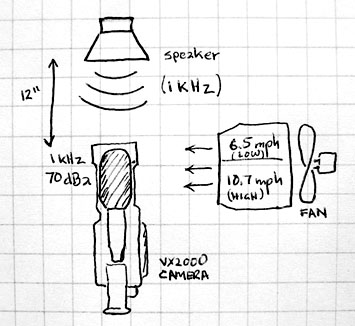How well do windscreens work?

VX2000 Windscreens
by John Beale Nov. 3, 2002
I've seen various suggestions for adding a wind screen to
the built-in microphone on the VX2000 camera. The idea of any windscreen is
to gently slow down the oncoming air before it hits the microphone element
and swirls around it, which causes air turbulence and low-frequency noise
that adds rumbles or howling noises to the soundtrack. Wrapping any foam or
fabric around the mic will reduce the impact of the air, which is good, but
there is a trade-off involved since the wind screen will also absorb some
of the desired sound, which is bad. Screening material will absorb more sound
at higher frequencies. For a given size and type of windscreen, and a given
wind speed, there is some optimum amount of absorbing material which will
maximize the desired sound while minimizing wind noise. Larger windscreens
in general can be better than small ones, but there is a practical limit to
size when the microphone is mounted on a camera.
You can make a quantitative measure of the effect of a wind screen by looking
at the audio spectrum of the recorded sound. Noise generated by moving air
is a broad spectrum concentrated in low frequencies, eg. from 10 Hz to 300
Hz. I made some measurements under controlled conditions of three cases: the
camera with no windscreen, a foam windscreen from Radio Shack, and the foam
screen plus a slightly fuzzy sock over it. My conclusions are listed below
under "Results".
Devices tested:
Sony model DCR-VX2000 MiniDV camera, S/N 1012162
Radio Shack std.-size mic windscreen, #33-373 ($2.99)
Mervyn's "slipper socks": 95% polyester, 5% spandex ($5.25)
Test equipment:
RS #33-2050 sound meter (calibrated to lab standard, +/- 0.5
dB)
Ducted floor fan, measured fan speed 6.5 mph (low), 10.7 mph (high)
CD player with custom 1 kHz tone CD-R.
bookshelf-type speaker.
I used a 1 kHz sinewave tone directly ahead of the camera to simulate a
desired signal (since that is in the middle of the important speech band).
I had the source of interference (the wind) blowing from the right. In the
results there is some difference in the response of the left (blue) and right
(pink) audio spectrum output.
I placed the speaker about 12 inches from the microphone. I measured the
1 kHz tone level from the speaker at the position of the camera's microphone
(without the fan on) at 70 dBa. Due to the 1/R^2 falloff of sound with distance,
the sound level is very sensitive to position. I did all measurements with
the camera fixed on a tripod to eliminate this variable. With the fan on,
air is flowing towards the camera from the right side at a speed of 6.5 mph
(low) or 10.7 mph (high). I have a separate page on
measuring airspeed
from a fan.
I had the camera in AGC mode (auto-gain). The camera's chosen gain setting
varies, depending on the amound of wind rumble. However, by taking the ratio
of the steady 1 kHz pilot tone to the level of wind noise, I can accurately
compare the effect of windscreens. Using a narrow filter to isolate the 1
kHz tone, I see that the AGC responds to the wind noise by continually changing
the gain about +/- 3 dB at high wind and no windscreen, but with the foam+sock
under the same conditions the variation is less; about +/- 1 dB.
I transferred the video via firewire to my PC and exported just the audio as a WAV file.
I generated the audio spectra with Cool Edit 2000 from syntrillium.com.
Cool Edit is also a useful general-purpose audio editing application.
Results
The separate audio spectra tell the story in each case. Based on the amplitude
of the 1 kHz tone compared with the low-frequency
rumble from the wind (10 Hz - 300 Hz range) the foam windscreen is a clear
improvement over no windscreen, reducing wind noise by 12 dB (high speed)
and 4 dB (low). The sock over the foam windscreen improves the signal/noise
ratio further, reducing noise 17 dB (high speed) and 9 dB (low) compared
with no screen. Adding two layers of sock over the foam windscreen is worse
than just one layer, apparently due to the greater total sound absorption
at high frequencies.
On the "high speed" cases, note that the spectral
peaks around 70, 210 and 280 Hz are generated by the rotating fan blades
so they represent "real" signals, rather than just wind noise.
Note that the high wind speed of about 11 mph might be
slow for a car, but it is a quite noticible breeze and I seldom try to record
audio in this much wind. Practically speaking, the foam+sock windscreen worked very
well while I was recording audio outdoors on a breezy ranch in California's central valley.
For the fashion conscious, the black sock looks similar to a commercial windscreen.
Back
to main page.


